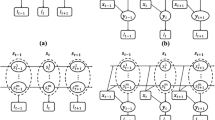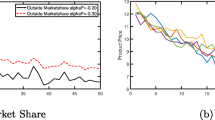Abstract
We develop discrete choice models that account for parameter driven preference dynamics. Choice model parameters may change over time because of shifting market conditions or due to changes in attribute levels over time or because of consumer learning. In this paper we show how such preference evolution can be modeled using hierarchial Bayesian state space models of discrete choice. The main feature of our approach is that it allows for the simultaneous incorporation of multiple sources of preference and choice dynamics. We show how the state space approach can include state dependence, unobserved heterogeneity, and more importantly, temporal variability in preferences using a correlated sequence of population distributions. The proposed model is very general and nests commonly used choice models in the literature as special cases.
We use Markov chain monte carlo methods for estimating model parameters and apply our methodology to a scanner data set containing household brand choices over an eight-year period. Our analysis indicates that preferences exhibit significant variation over the time-span of the data and that incorporating time-variation in parameters is crucial for appropriate inferences regarding the magnitude and evolution of choice elasticities. We also find that models that ignore time variation in parameters can yield misleading inferences about the impact of causal variables.
Similar content being viewed by others
References
Albert, J., & Chib, S. (1993). Bayesian analysis of binary and polychotomous data. Journal of the American Statistical Association, 88, 667–679.
Allenby, G. M., & Lenk, P. J. (1994). Modeling household purchase behavior with logistic normal regression. Journal of the American Statistical Association, 89(428), 1218–1231.
Allenby, G. M., & Lenk, P. J. (1995). Reassessing brand loyalty, price sensitivity, and merchandising effects on consumer brand choice. Journal of Business and Economic Statistics, 13(3), 281–289.
Allenby, G. M., & Rossi, P, E. (1999). Marketing models of consumer heterogeneity. Journal of Econometrics, 89, 57–78.
Barnard, J., McCulloch, R., & Meng, X. L. (2000). A natural strategy for modeling covariance matrices with applications to shrinkage. Statistica Sinica, 10, 1281–1311
Carter, C. K., & Kohn, R. (1994). On gibbs sampling for state space models. Biometrika, 81, 541–553.
Chintagunta, Pradeep K. (1993). Investigating purchase incidence, brand choice and purchase quantity decisions of households. Marketing Science (pp. 184–208). Spring.
Dekimpe, M., G., & Hanssens, M., D. (1995). The persistence of marketing effects on sales. Marketing Science, 14, 1–21.
Erdem, T. (1996). A dynamic analysis of market structure based on panel data. Marketing Science, 15, 359–378.
Gelfand, A. E., & Smith, A. F. M. (1990). Sampling based approaches to calculating marginal densities. Journal of the American Statistical Association, 85, 398–409.
Geweke, J. F., Keane, M. P., & Runkle, D. E. (1997). Statistical inference in the multinomial probit model. Journal of Econometrics, 80, 125–165.
Guadagni, P. M., & Little, J. D. C. (1983). A logit model of brand choice calibrated on scanner data. Marketing Science, 2(3), 203–238.
Hastings, W. K. (1970). Monte carlo sampling methods using markov chains and their applications. Biometrika, 57, 97–109.
Hausman, J., & Wise, D. (1978). A conditional probit model for qualitative choice: Discrete decisions recognizing interdependence and heterogeneous preferences. Econometrica, 45, 319–339.
Heckman, J. J., Manski, C. F., & McFadden, D. (1981). Statistical models for discrete panel data. Structural analysis of discrete data with applications. pp. 114–178, Cambridge: MIT Press.
Jedidi, K., Mela, F. C. & Gupta, S. (1999). Managing advertising and promotion for long-term profitability. Marketing science, 18, 1–22.
Kalman, R. E. (1960). A new approach to linear filtering and prediction. Journal of Basic Engineering, 83, 95–108.
Kass, R. E., & Raftery, A. E. (1995). Bayes factors. Journal of the American Statistical Association, 90, 773–795.
Keane, M. (1997). Modeling heterogeneity and state dependence in consumer choice behavior. Journal of Business and Economic Statistics, 15(3), 310–327.
McCulloch, R., & Rossi, P, E. (1994). An exact likelihood analysis of the multinomial probit model. Journal of Econometrics, 64, 207–240.
McCulloch, R., Polson, N. G. & Rossi, P. E. (2000). A Bayesian analysis of the multinomial probit model with fully identified parameters. Journal of Econometrics, 99, 173–193.
McCulloch R., & Rossi, P. E. (2000). Reply to nobile. Journal of Econometrics, 99, 347–348.
McFadden, D. L. (1973). Conditional logit analysis of qualitative choice behavior, In P. Zarembka (ed.), Frontiers in Econometrics, (pp. 105–142), New York: Academic Press.
Mela, F. C., Gupta, S., & Lehmann, L, R. (1997). The long-term impact of promotions and advertising on consumer brand choice. Journal of Marketing Research, 34, 248–261.
Metropolis, N., Rosenbluth, A. W., Rosenbluth, M. N., Teller, A. H., & Teller, E. (1953). Equations of state calculations by fast computing machine. J. Chem.Phys, 21, 1087–1091.
Neal, R. M. (2003). Slice sampling (with discussion). Annals of statistics pp. 705–767.
Newton, M. A., & Raftery, A. E. (1994). Approximate bayesian inference by the weighted likelihood bootstrap (with discussion). Journal of the Royal Statistical Society, Series B, 56, 1–48.
Nobile, A. (2000). Comment: Bayesian multinomial probit models with a normalization constraint. Journal of Econometrics, 99, 335–345.
Pauwels, K., Hanssens, M. D., & Siddarth, S. (2002). The long-term effects of price promotions on category incidence, brand choice and purchase quantity. Journal of marketing research.
Priestly, M. B. (1980). State-dependent models: A general approach to non-linear time series analysis. Journal of Time Series Analysis, 1, 47–71.
Roy, R., Chintagunta, P. K., & Haldar, S. (1996). A framework for investigating habits, the hand of the past. and heterogeneity in dynamic brand choice. Marketing Science, 15(3), 280–299.
Seetharaman, P. B. (2003). Modeling multiple sources of state dependence in random utility models of brand choice: A distributed lag approach. Marketing Science, forthcoming.
Fruhwirth-Schnatter, S. (1994). Data augmentation and dynamic linear models. Journal of Time Series Analysis, 15, 183–202.
Tanner, M. A., & Wong, W. H. (1987). The calculation of posterior distributions by data augmentation, (with discussion). Journal of the American Statistical Association, 82, 528–550.
Tsay, R., & McCulloch, R. (1994). Statistical analysis of economic time series via markov switching models. Journal of Times Series Analysis, 15, 523–539.
West, M., & Harrison, P. J., (1997). Bayesian forecasting and dynamic models, 2nd Edition. New York: Springer-Verlag.
Yang, S., Chen, Y., & Allenby, G. (2003). Bayesian analysis of simultaneous demand and supply. Quantitative marketing and economics, 1(3), pp. 251–275.
Author information
Authors and Affiliations
Additional information
This paper is based on the first author's doctoral dissertation.
Rights and permissions
About this article
Cite this article
Lachaab, M., Ansari, A., Jedidi, K. et al. Modeling preference evolution in discrete choice models: A Bayesian state-space approach. Quant Market Econ 4, 57–81 (2006). https://doi.org/10.1007/s11129-006-6559-x
Issue Date:
DOI: https://doi.org/10.1007/s11129-006-6559-x




